Now Is the Time
Christopher Auchter
2019
| 16 min
Selections and Awards
Official SelectionSundance Film Festival, Park City, Utah, USA (2020)
Official SelectionToronto International Film Festival, Toronto, Canada (2019)
Official SelectionVancouver International Film Festival, Vancouver, Canada (2019)
Official SelectionSan Francisco American Indian Film Festival, San Francisco, California (2019)
Official SelectionimagineNATIVE Film + Media Arts Festival, Toronto, Canada (2019)
Official SelectionCamden International Film Festival, Camden, USA (2019)
Official SelectionMaoriland Film Festival, Otaki, New Zealand (2020)
Official SelectionBig Sky Documentary Film Festival, Missoula, Montana, USA (2020)
Official SelectionReel 2 Real International Film Festival for Youth, Vancouver, Canada (2020)
Official SelectionAFI DOCS Film Festival, Los Angeles, California, USA (2020)
Indigenous Category Golden Sheaf Award Winner Golden Sheaf Award, Yorkton Film Festival, Yorkton, Saskatchewan, Canada (2020)
Documentary Arts/Culture Category Golden Sheaf Award WinnerYorkton Film Festival, Yorkton, Saskatchewan, Canada (2020)
Best Canadian Short Film Jury PrizeGimli Film Festival, Manitoba, Canada (2020)
Official Selection - Short List: ShortsDOC NYC, New York, USA (2020)
Prix du meilleur court canadien - prix Radio-Canada Espaces autochtones International First Peoples' Festival, Montreal, Canada (2020)
Prix international de la relève Main Film International First Peoples' Festival, Montreal, Canada (2020)
When internationally renowned Haida carver Robert Davidson was only 22 years old, he was instrumental in changing the history of his people forever. With help from his grandparents, his father, and his younger brother Reg, Davidson committed to carving the first new totem pole in Old Massett in almost a century.
On the 50th anniversary of the pole’s raising, Haida filmmaker Christopher Auchter steps easily through history to revisit that day in August 1969, when the entire village gathered to celebrate the event that would signal the rebirth of the Haida spirit.
Resplendent with animation, emotional interviews, and original footage shot by what was then known as the NFB’s Indian Film Crew, Now Is the Time captures three generations of Eagle and Raven clan working together to raise the pole in the old way, inching it higher and higher, until it stands proud and strong against the clear blue sky.
In 1969, when internationally renowned Haida carver Robert Davidson was only 22 years old, he was instrumental in changing the history of his people forever.
During visits to museums in Vancouver, Davidson had seen photographs of Old Massett Village, with its forest of totem poles facing the sea; but at home there was nothing left. It wasn’t just the totems that had been razed and destroyed: Haida songs, ceremonies, and culture had also been obliterated. “I would go and visit the elders, and they seemed really, like, not connecting to anything,” he says. “I could feel the sadness, and I wanted to create an occasion for them to celebrate one more time.”
With help from his grandparents, his father, and his younger brother Reg, Davidson committed to carving the first new totem pole in almost a century.
On the 50th anniversary of the pole’s raising, Haida filmmaker Christopher Auchter steps easily through history to revisit that day in August 1969, when the entire village gathered to celebrate an event that would signal the rebirth of the Haida spirit. Resplendent with original footage shot by what was then known as the NFB’s Indian Film Crew, Now Is the Time is filled with archival images, animation, and emotional interviews with Robert, Reg, and Haida scholar Barbara Wilson.
The film’s bright, kaleidoscopic scenes show women dancing in their bare feet, men egging each other on, elders wearing paper headdresses, and children drawn in gorgeous watercolour hues. Everywhere is the sound of laughter and tears, as three generations of Eagle and Raven clan come together to raise the pole in the old way, inching it higher and higher, until it stands proud and strong against the clear blue sky.
In his studio, Robert Davidson smiles at the memory. “I was just a young smart-aleck kid thinking I was going to teach the elders something, but it turned around,” he says. “It was the other way around.”
Short Synopsis
When internationally renowned Haida carver Robert Davidson was only 22 years old, he carved the first new totem pole on British Columbia’s Haida Gwaii in almost a century. On the 50th anniversary of the pole’s raising, Haida filmmaker Christopher Auchter steps easily through history to revisit that day in August 1969, when the entire village of Old Massett gathered to celebrate the event that would signal the rebirth of the Haida spirit.
40-word synopsis
On the 50th anniversary of the first new totem pole raising on British Columbia’s Haida Gwaii in almost a century, Haida filmmaker Christopher Auchter steps through history to revisit the day that would signal the rebirth of the Haida spirit.
A Message from Robert Davidson
With the release of Now Is the Time, I wanted to take the opportunity to provide some context for the story of the pole raising that took place in Massett on August 22, 1969.
For several decades, Massett did not have any totem poles or art because of the restrictions from Canadian laws under the Indian Act, which was first passed in 1876. This Act was later amended to outlaw us from practicing our ceremonies, including our songs and our dances.
It has been 50 years since my brother, Reg, and I carved the totem pole for Massett. My family, including my parents, Claude and Vivian, Naanii Florence and Tsinii Robert, and Susan, was tremendously supportive throughout that time. My uncles, Alfred Davidson, Sam Davis, and Victor Adams, my aunties, and many Elders provided me guidance for the project and the celebration on the day of the pole raising.
Dad, of his own free will, walked the forest for two weeks looking for a suitable tree. Mom and Susan gave unending support throughout the summer. Audrey Hawthorn, then Curator of the UBC Museum, applied for and received a $3,000 cultural grant for this project. Naanii and Tsinii provided endless guidance and support and opened their home to host numerous meetings with the Elders to discuss history and what was involved in raising a totem pole. All of the preparation and consultation with the Elders took place during the summer at those meetings. Song and dance practices were held after the meetings, and Naanii even demonstrated one of the dances with a brown paper bag with holes cut out for her eyes because we had no masks. It was truly a spiritual experience seeing all the joy expressed through the Elders’ singing and dancing – these Elders who were all 70 years old and over. After school was out Reg helped to carve. Even though it was the first time he had ever carved, it was as if he had carved before. We worked 10-12 hours a day, six days a week most weeks.
The idea to carve and raise the totem pole in Massett was inspired by my friendship with the Elders of the day. When I moved to Vancouver, I saw the great art of my ancestors then I came home and saw no art in the village, because we had been muted and outlawed from practicing our ceremonies and way of life. I also sensed a feeling of sadness from the Elders, and I wanted to create a reason for them to celebrate one more time in a way they knew how. This motivated me to commit to carving the totem pole. There was never a question or doubt from my parents or grandparents that this could be accomplished.
The sun shone brightly on the day of the totem pole raising. It was like magic. The pole was raised as if it was an everyday event. We were all guided by a power greater than ourselves. Tsinii helped Dad to give direction to the pole pullers. After the totem pole was raised, people spontaneously began to sing and dance around the totem pole. Many of the Haida wore paper headpieces, and there were only two drums, one was a toy drum that my tsinii used. It was a celebration – a rebirth – we were able to reconnect with our spirituality once more. Many Haida from Skidegate and Hydaburg and yaads xaadee from out of town came to witness the pole raising and be part of the celebration.
That evening a potlatch was held in the community hall that was co-sponsored by the Massett Band Council and the Davidson family.
Director's Statement
Take a moment and imagine our world without art. Now imagine that after nearly a century without art, an event occurs that allows it to come flooding back again.
On August 22, 1969, the small community of Old Massett on Haida Gwaii, an archipelago off Canada’s northern Pacific Coast, erected a 40-foot totem pole carved by 20-year-old Robert Davidson and his 14-year-old brother, Reg. The ceremony was led by community elders who ensured it would be conducted in the old ways. Ways that had been banned, pushed into the darkness and nearly forgotten. When Robert started carving the pole earlier that summer, the elders began to gather, hosting meetings where they planned out how to do it all traditionally, thus teaching a new generation the cultural ways of the Haida.
The raising of the totem pole in 1969 freed so many aspects of our culture from the confines of homes whose curtains had been drawn to keep the eyes of the authorities and the church reverend from seeing the Haida customs being practised. It freed carving, singing, dancing, regalia creation and the potlatch ceremony. (The potlatch, a system so critical to the functioning and stability of Haida society, had been banned for nearly 50 years.) The totem-pole raising was a new beginning, sending a signal to the Haida people that it’s okay to be you, it’s okay to create works and live in your unique way.
Flash forward to the present, and a half-century separates us from that remarkable day in Old Massett. I can see what a difference that day has made for my community, the difference it made for me growing up on Haida Gwaii—how as a young boy, I heard Haida songs and saw Haida art on our kitchen window in the mornings as I ate my cereal. I was immersed in those aspects of our culture; it just was. Robert Davidson (the carver of the totem pole) grew up in a different era. He didn’t hear his first Haida song until he was 16 years old. So, he did something about it: he carved, and it helped open a locked door, which allowed a culture to thrive again.
So, imagine your world without art, and now, through my film, witness for yourself what happens when art is brought back again. Experience the joy!
Waats’daa, Christopher Auchter
Director of Now Is the Time
Trailer
Clips
Images
Loading...
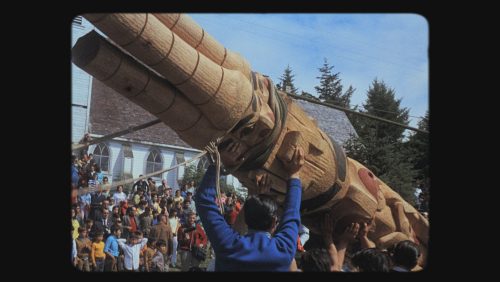
Download
Loading...

Download
Loading...
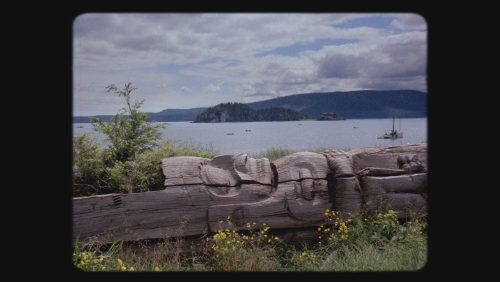
Download
Loading...
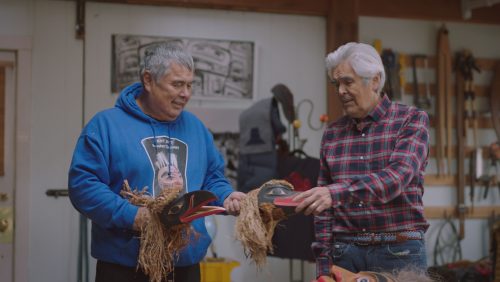
Download
Loading...
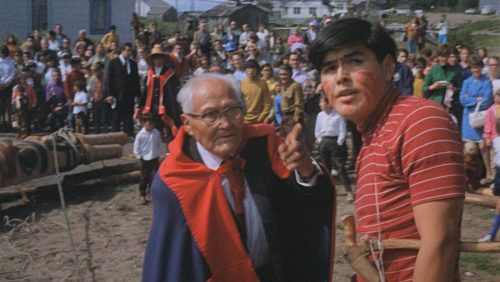
Download
Loading...
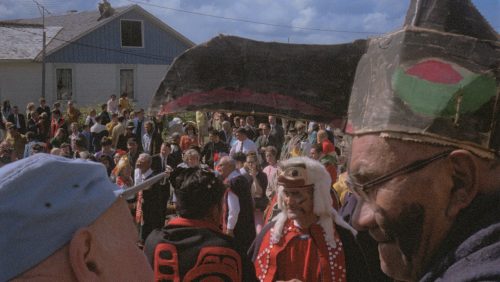
Download
Promotional Materials
Team
Christopher Auchter
Writer & Director
Photo
Photo : Tracy Auchter
Selwyn Jacob
Producer
Photo
Photo : NFB
Shirley Vercruysse
Executive Producer
Photo
Photo : Myriam Frenette
Teri Snelgrove
Producer
Photo
Photo : NFB
Credits
Featuring
Robert Davidson
Reg Davidson
Barbara Wilson
And the Voices of
Jane Kristovich
Percy Rodriguez
Joe Weir
Florence Davidson
Victor Adams
Written and Directed by
Christopher Auchter
Producer
Selwyn Jacob
Associate Producer
Teri Snelgrove
Line Producer
Jennifer Roworth
Director of Photography
Asia Youngman
Editor
Sarah Hedar
Composer
Genevieve Vincent
Sound Design & Re-Recording Mixer
Chris McLaren
Additional Camera
Vince Arvidson
Sound Recordist
Ramsay Bourquin
First Assistant Camera
Odessa Shuquaya
Gaffer
CameronWatts
Mike Hjorth
Production Coordinator
Kristyn Stilling
Technical Coordinator
Wes Machnikowski
Animation
Christopher Auchter
Animation Rigger
Tara Baker
Stop Motion Animation
Alicia Eisen
Stop Motion Animation Consultants
Alicia Eisen
Kaho Yoshida
Colourist
Lorne Wright
Thank You
Nikita Auchter
Tracy & Tony Auchter
Maddex & Logan Auchter
Kevin Borserio (Skidegate Haida Immersion Program)
Dr. Margaret B. Blackman
Tyson Brown
Delores Churchill
Terri-Lynn Williams-Davidson
Babs Hageman
Lisa Hageman
Imbert Orchard
Tug Phipps
Chris Sheldon
Helen Shuttlewood
Craig Smith
Lisa Telford
Michael Nicoll Yahgulanaas
Thank You
Barbara Wilson
Now is the Time was filmed on location
on the traditional territory of the Semiahmoo, Tsleil-Waututh,
S’ólh Téméxw (Stó:lō),and W̱SÁNEĆ First Nations
Archives
NFB Archives
Royal BC Museum and Archives
CBC Archive Sales
Musicians
Peggy Lee, Violoncello
David Brown, Contrabass
Cameron Wilson, Violin
Genevieve MacKay, Viola
Music Mixer
Lori Castro
Marketing Manager
Kay Rondonneau
Publicist
Katja De Bock
Studio Administrator
Carla Jones
Executive Producer, BC & Yukon Studio
Shirley Vercruysse
Executive Director, English Program
Michelle van Beusekom
Produced in association with Knowledge Network
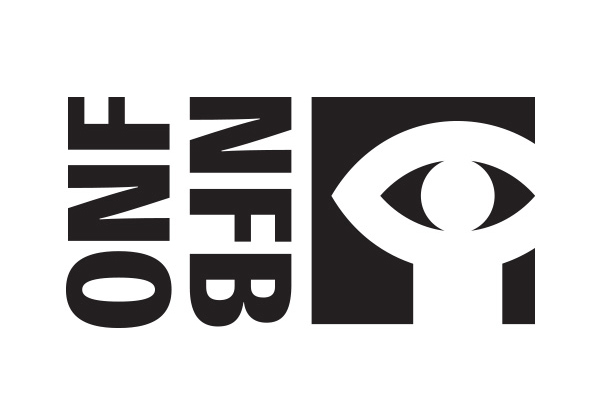
NFB.ca
©2019 National Film Board of Canada
Media Relations
-
About the NFB
For more than 80 years, the National Film Board of Canada (NFB) has produced, distributed and preserved those stories, which now form a vast audiovisual collection—an important part of our cultural heritage that represents all Canadians.
To tell these stories, the NFB works with filmmakers of all ages and backgrounds, from across the country. It harnesses their creativity to produce relevant and groundbreaking content for curious, engaged and diverse audiences. The NFB also collaborates with industry experts to foster innovation in every aspect of storytelling, from formats to distribution models.
Every year, another 50 or so powerful new animated and documentary films are added to the NFB’s extensive collection of more than 14,000 titles, half of which are available to watch for free on nfb.ca.
Through its mandate, its stature and its productions, the NFB contributes to Canada’s cultural identity and is helping to build the Canada of tomorrow.